
The plane circles over Marrakech. The pilot informs us that Marrakech airport is not expecting us due to being closed for an air-show. He adds cheerfully, almost incidentally: “ We have about ten minutes of fuel left”. He will keep us informed. Nothing like inspiring the passengers to remain composed. Meanwhile lumpy sandy scenery pops up between snow skimmed mountains and random bits of greenery going round and round. About 30 minutes later we land. Not much to show for an air-show. Mostly Tui and EasyJet and BA aircraft pulled to one side of the tarmac.
Long long dreary queues greet the passengers after disembarkation and the passport control officer desires in depth details of one’s movements. Baggage collected, it all has to be shoved on conveyor belts through X ray machines. Emerge into the light, having been fleeced for 10% commission on my not so modest cash withdrawal at a money exchange desk doing a thriving business with naïve/ stupid/ shattered travellers too bemused to think straight. At least the weather is reliably sunny and the hotel in the more modern French built part of Marrakech is peach coloured with pool and palm trees. Toilet doesn’t work.
I have booked a tour encompassing Morocco’s different landscapes: the coast, the High Atlas and the Sahara desert; the old capitals of Marrakech and Fez; the new capital of Rabat; the city of business, Casablanca; the film capital of Ouarzazate; Roman ruins and Berber villages. I had wanted to visit the country many years before but the border between Morocco and Algeria was closed due to the Western Sahara War and, at the time, plans were to sally south across the Sahara desert. Thus, I had chosen a different route.
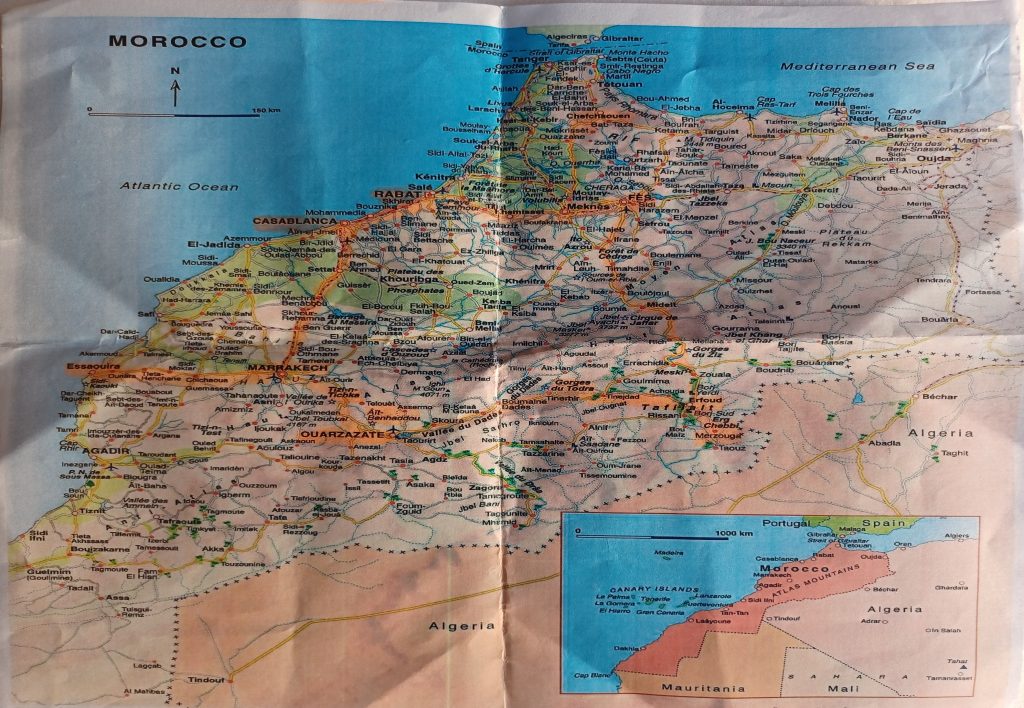
Koutoubia Mosque
I have a day to explore Marrakech before the tour starts. Good move. Take the longish walk to the old medina via well laid roads with more peachy coloured buildings and palm trees. This is the area of Western hotels. Not unattractive. The most distinct landmark in the city is the Koutoubia mosque which, unlike many buildings, is not covered with a peachy clay coating but has been left with its original stonework exposed. I head towards it.
Cross the road where a large round-a-bout sits in front of the Bab Jdid gate, one of the entrances within the nine kilometre wall of the medina. Cars, minibuses, tourist coaches, and horses pulling green carriages circle around the round-a-bout, within which sits a large fountain.
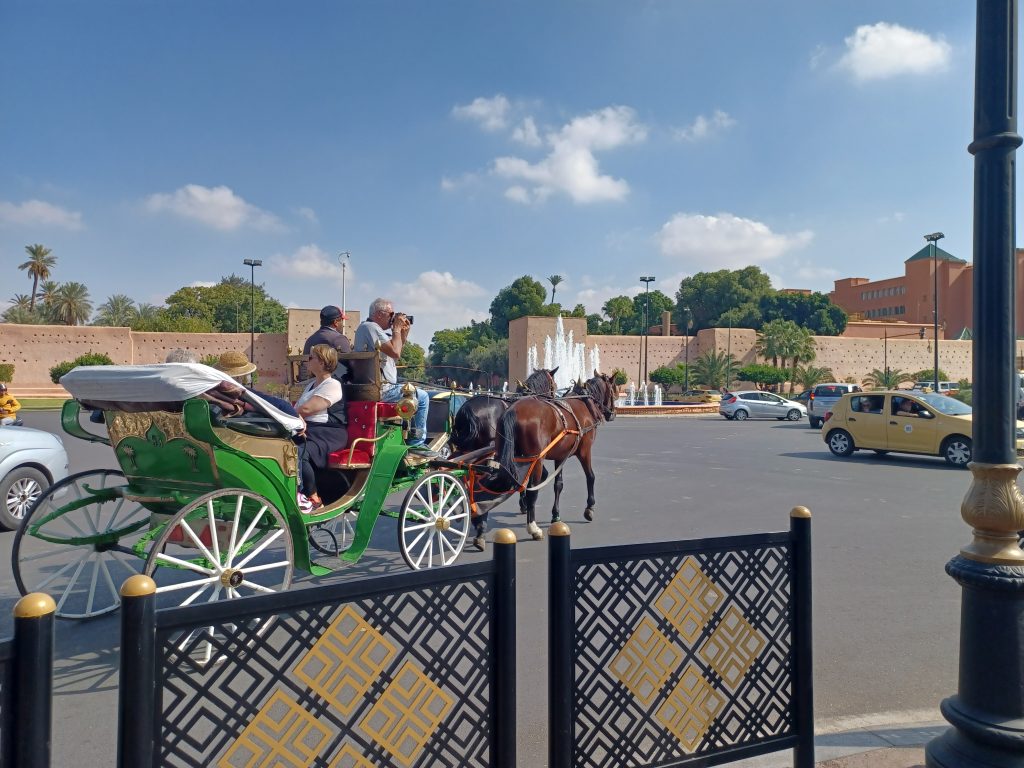
I note that what at first I thought was a palm tree is a cunningly disguised mobile phone mast. Impressed. Enter the medina. Gardens of lemon and orange trees sit lushly each side of the paved path leading to the mosque. Two largish fountains of blue and white and green and white tiles respectively are stationed in front of and behind an irrigation channel. I run the gauntlet of would-be guides, pomegranate stalls and artisans selling souvenirs either side of said channel. Work out that the best way to evade their attention is to look straight in front of me avoiding eye contact and any form of engagement.
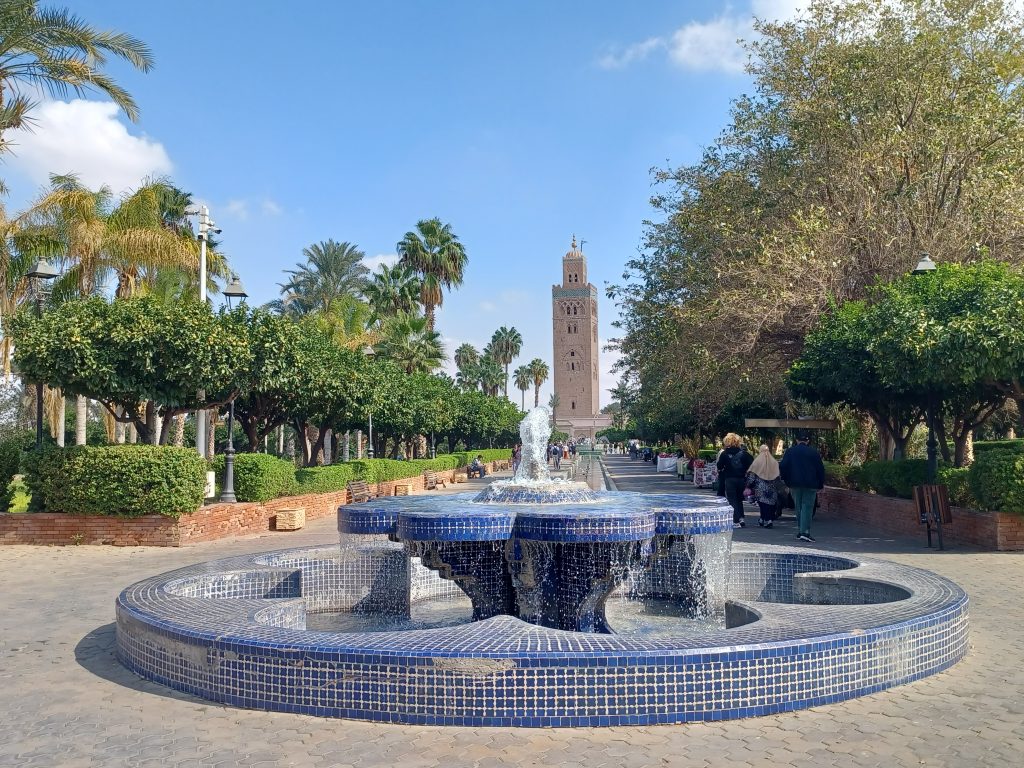
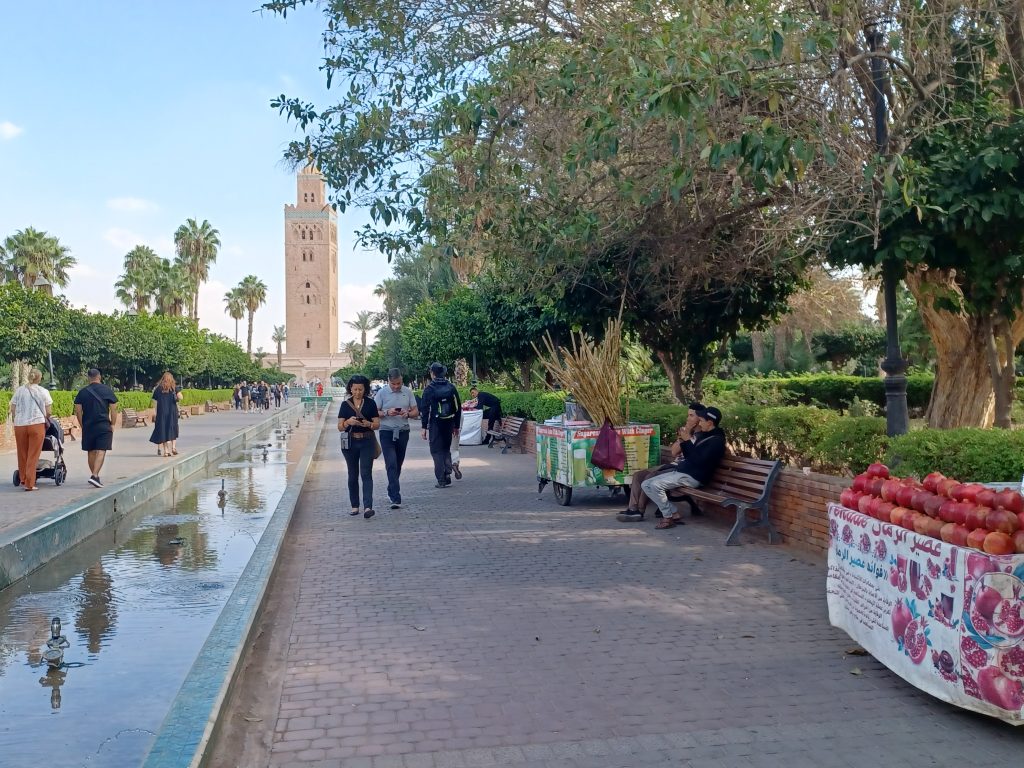
I arrive outside the mosque. Not allowed in, as the only mosque in Morocco that permits non-Muslims to enter is the Hassan II mosque in Casablanca. Stunning minaret. Reminds me of the Giralda, the bell tower of Seville Cathedral, which was modelled on this one (see Spain, part 1). Sure enough, some information on a board tells me that this one served as a model for the Giralda and is one of five great mosques built by the Almohad dynasty. An architectural masterpiece. The mosque is the second one on the site. The first mosque had been built by the Berbers, who founded the Almoravid dynasty. Said Berbers established a base at Marrakech, which became the centre of their empire. Their mosque, however, was not correctly aligned with Mecca. So the Almohads built this one around 1158.
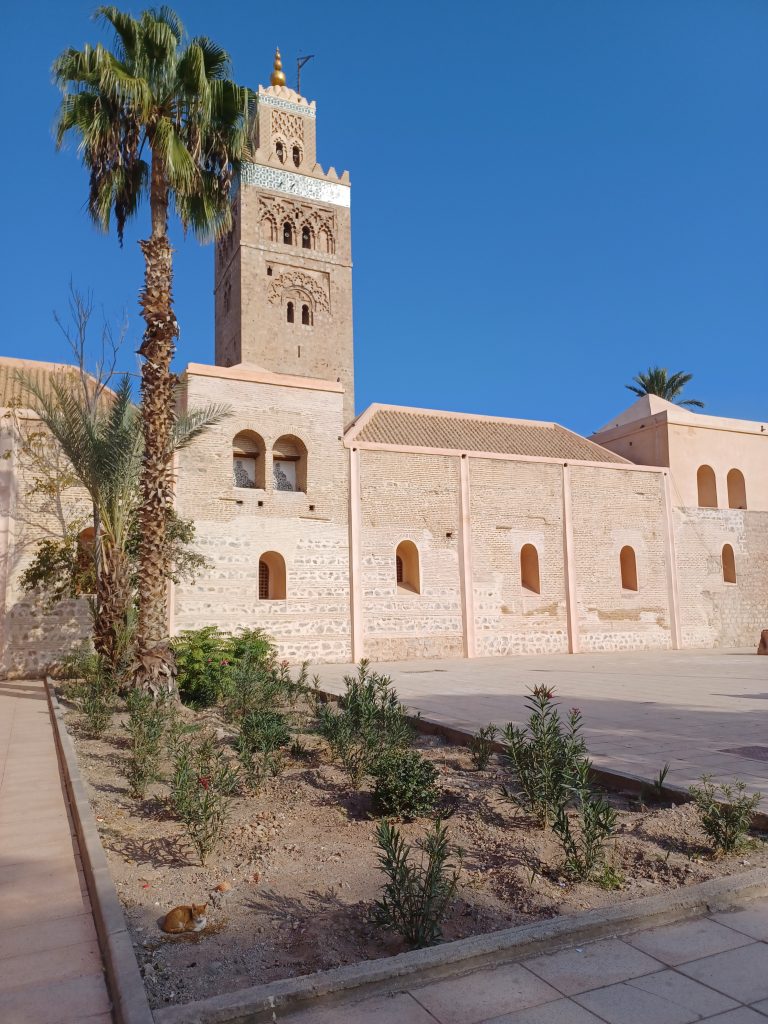
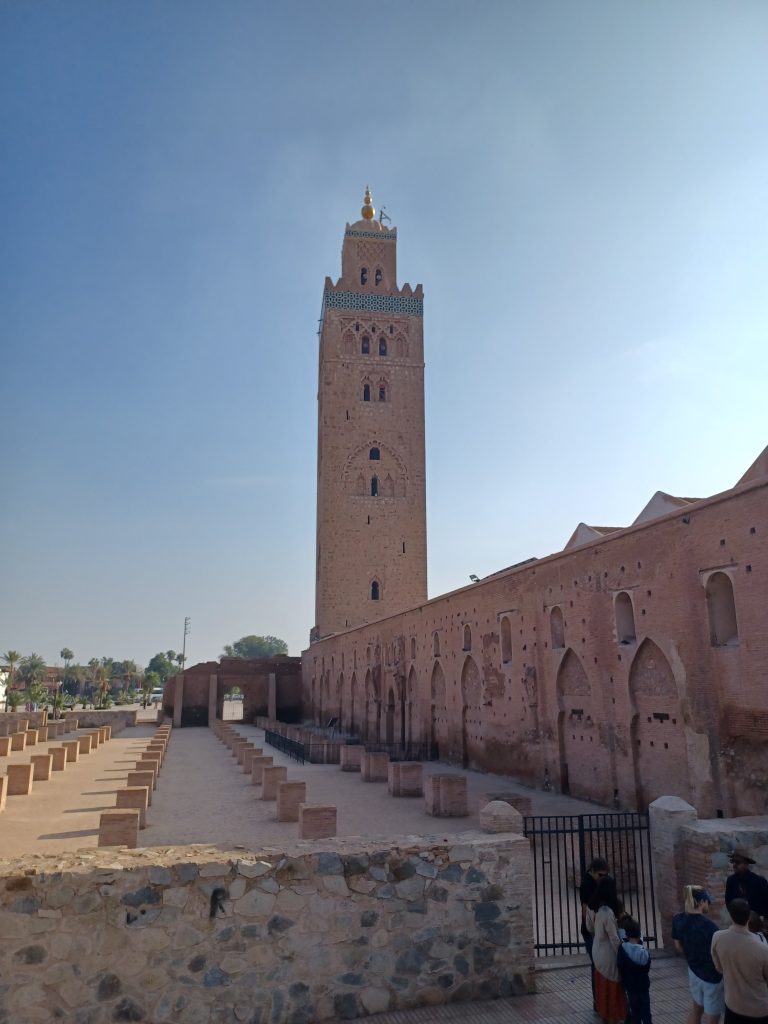
Djemaa El Fna
Wander through the square the other side of the mosque. Some men are dressed in long red outfits with large hats, carrying leather bags. Think they are selling water. I pass them and cross a busy road towards a line of horses and carriages, leading the way to the amorphous shaped ‘square’ of Jamaa El Fna or Djemaa El Fna, depending on your preference. A frenetic place, this is the heart of the city: snake charmers blow wailing pipes and thump tambourines and drums to swaying black cobras and horned vipers.
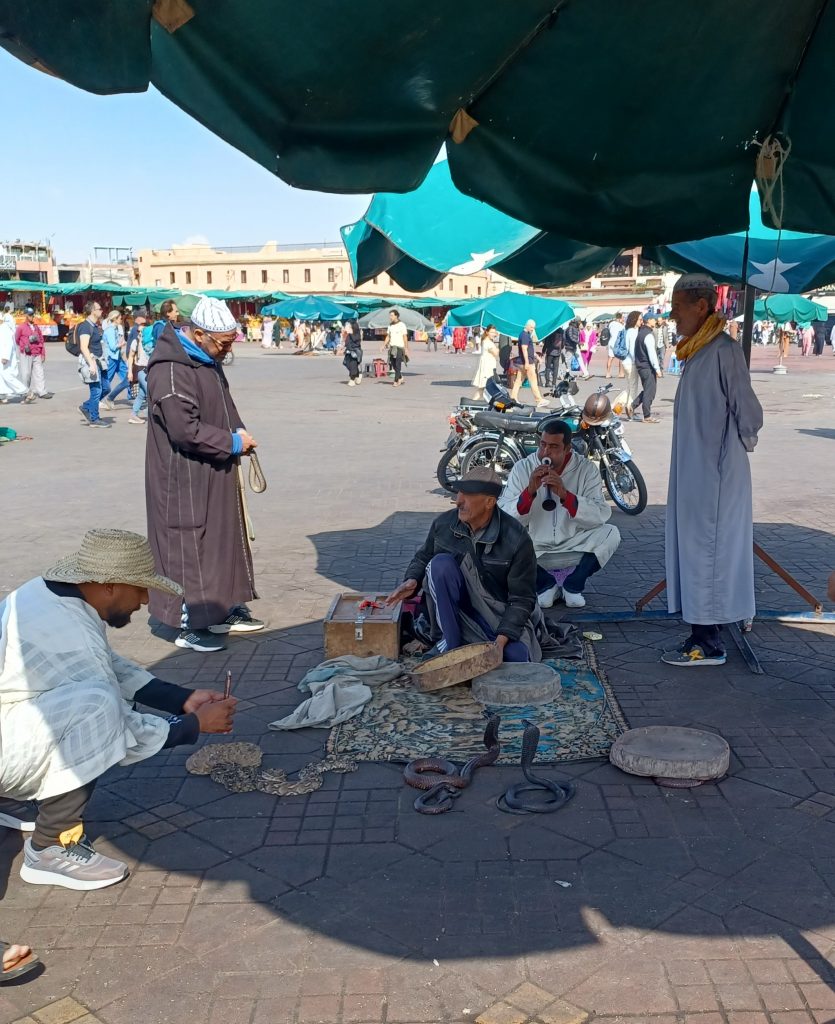
Musicians are out in force with people clustered around them on plastic chairs. One of them is collecting cash from the onlookers in his tambourine. Gets a bit excited when a tourist takes a photograph of them without paying for the privilege. Conjurers; acrobats; monkeys on chains; ladies offering henna tatoos and nail manicures; fruit and vegetable stalls with the produce laid out in triangular patterns; and beggars fill the square. A cat covered in flies squats by a palm tree stump and sandy yellow coloured taxis and motor bikes weave through it all. I begin to lose my sense of humour after nearly being run down a dozen times. I am told that at night time, this place really comes alive.
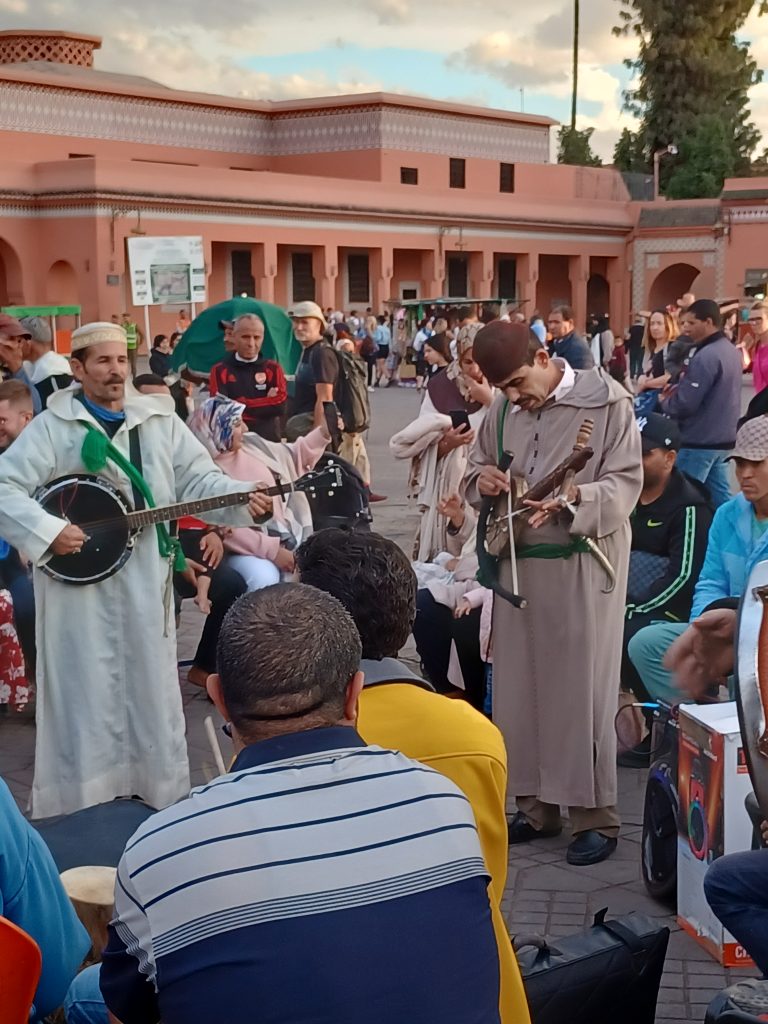
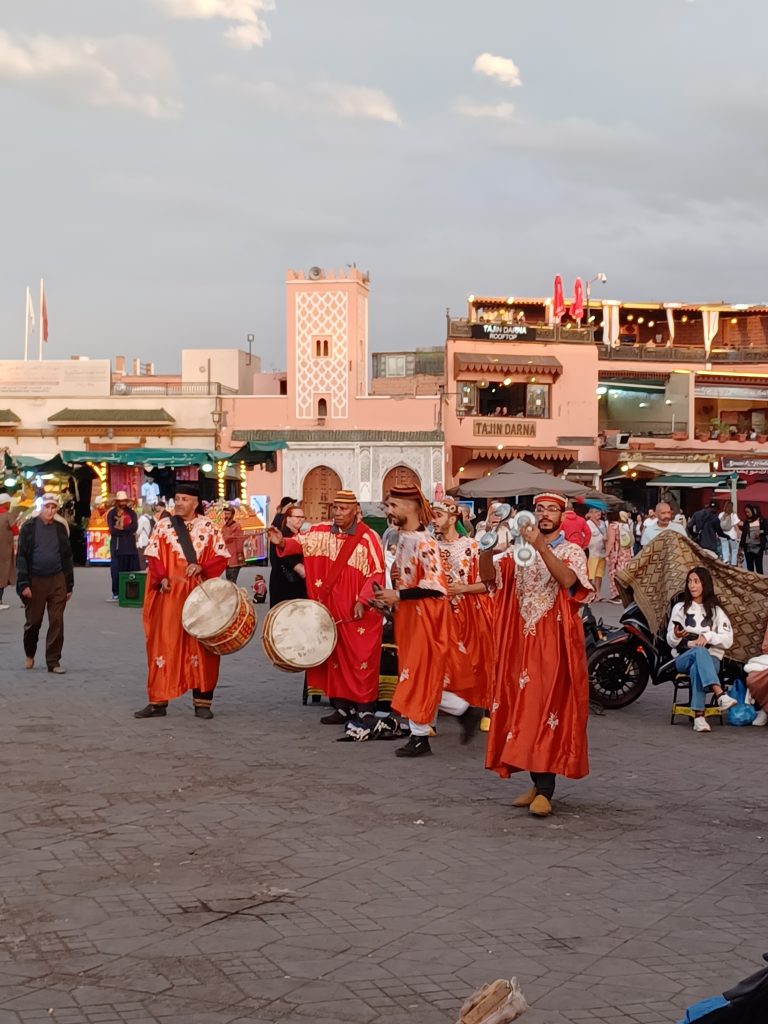
From the square lead several souqs, spindly alleyways full of artisan stalls, selling everything one could possibly desire: leather babouches (slippers), pouffes, saddle bags used by Tuareg nomads; bronze lamps, table tops, figurines; ceramic plates, tagines; wooden magic boxes, letter racks, bowls, chess sets, carvings of faces from West Africa; woven carpets, cushion covers; baskets; fridge magnets; soft camels of many colours; and a motley mix of authentic and fake fossils.
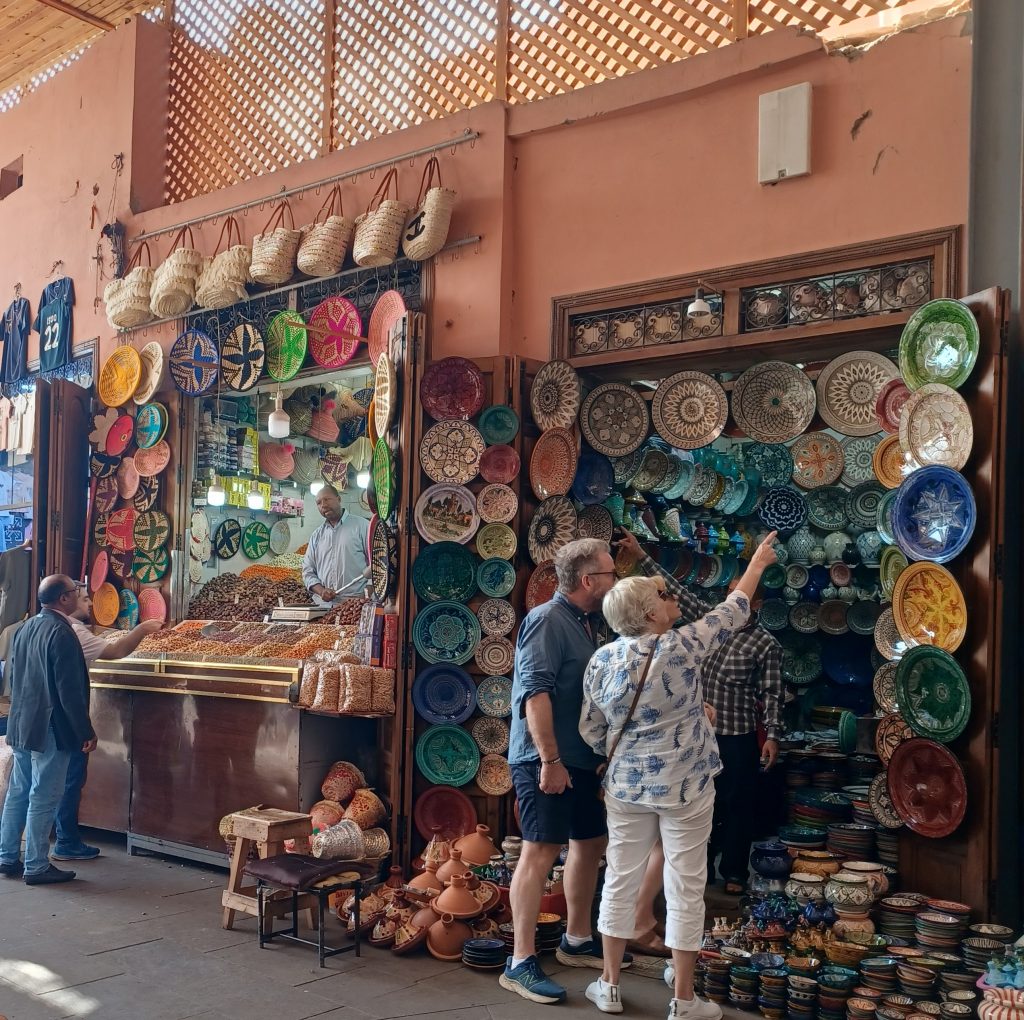
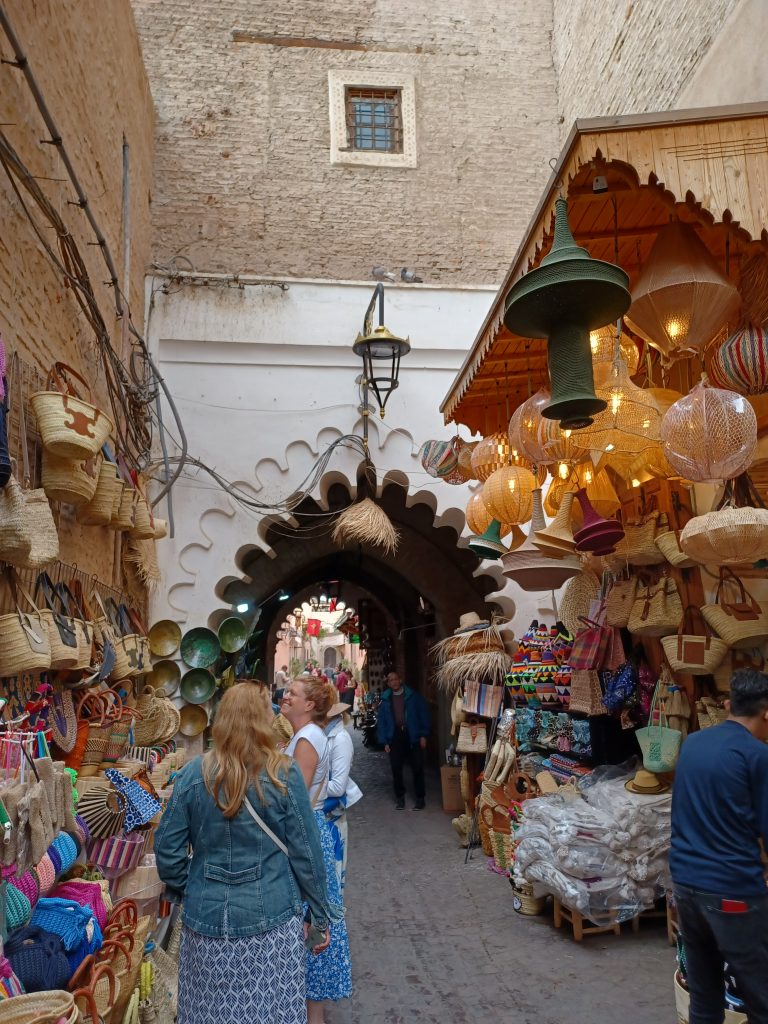
Some of the alleyways are a bit wider with wooden lattice rooves to let the light through. Motor bikes zip through them, and men shove large steel trolleys or lead donkeys burdened with goods. A feast for the senses or assault on the senses. Your call. Spices, prickly pear, sweet cakes. It is all there. “Bonjour Madame. Where you from?” “Welcome”. “Come see my shop!” “What is your best price?” “How much you pay?”
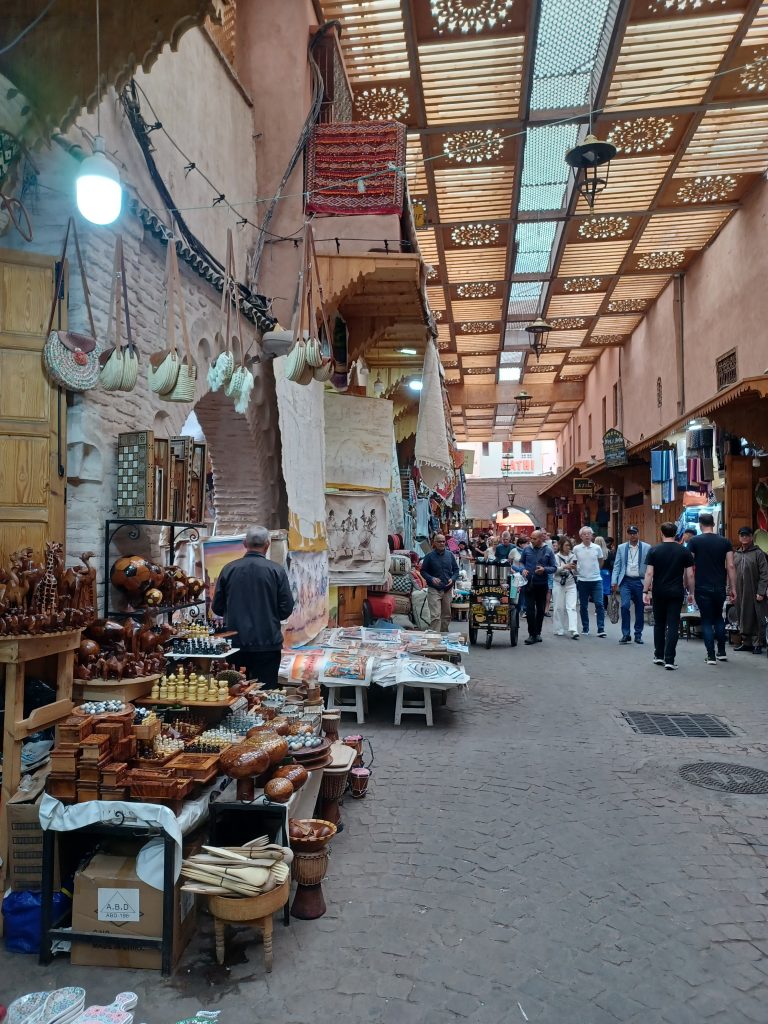
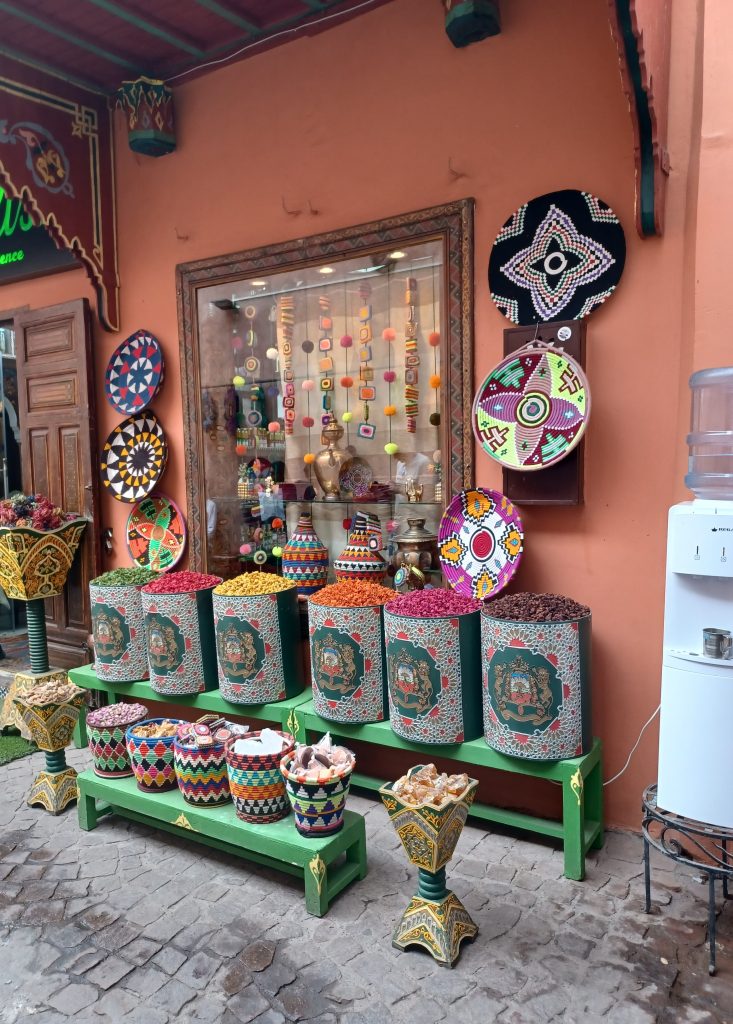
I beat a way through and enter a tiny tea shop. The owner addresses me in French. The French and Spanish divided Morocco between them in 1912. Marrakech was in the French part. The French left in 1956 but reminders of their rule persist. A Moroccan man in a white djellaba sits at the entrance to the tea shop, smoking a cigarette whilst his phone is charging. He chats to another man opposite. He has finished his tea. He looks cold, though to me it feels hot. I order té moroccain, black tea with lots of sugar. Savour its sweetness as other Moroccan men come and go. Then out into the fray once more.
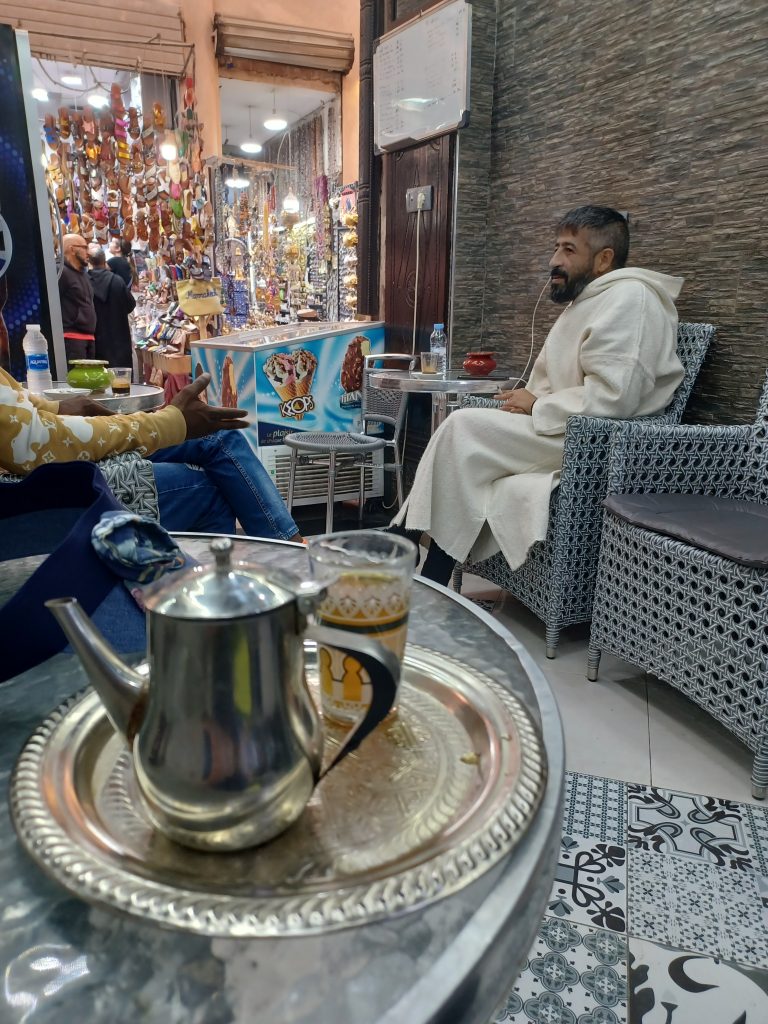
Le Jardin Secret
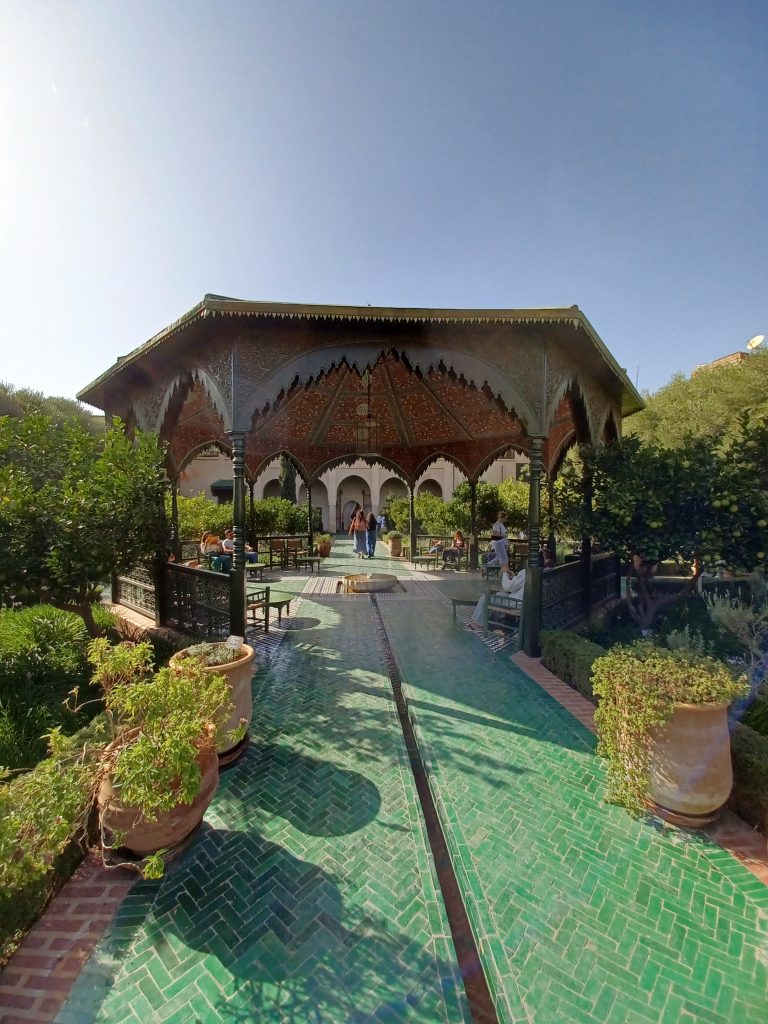
‘Le Jardin Secret’, the Secret Garden, calls. I had read about this haven in my guidebook. I get lost a few times in the labyrinth of souks but eventually find it. Shortish queue to enter. Not so very secret perhaps. I was hoping for a quiet oasis but there are dozens of people in this rather charming garden taking pictures of each other posing in front of every palm tree. Don’t see anyone actually taking much interest in the planting. Even so, it is a respite from the souks with its restful green hues and fragrant flowers. A splendid pavilion provides shady seating and a slender water filled furrow cuts through the zig zag paving.
I head for the café and order pineapple and mango juice with grenadine. Luscious. While waiting for nourishment to arrive, I read a poem about the garden inside the leaflet given to the tourists as they trickle in. A ‘mirage of a dream’ according to the poet, Georges de Noyâr. Nice poem, though the French version (the original) is better than the English translation, which doesn’t scan awfully well (opposite). After a longish while a tepid slice of quiche turns up. Leisurely ingest. Then take my leave of the secret garden and make my way back through the buzzing souks to the square.
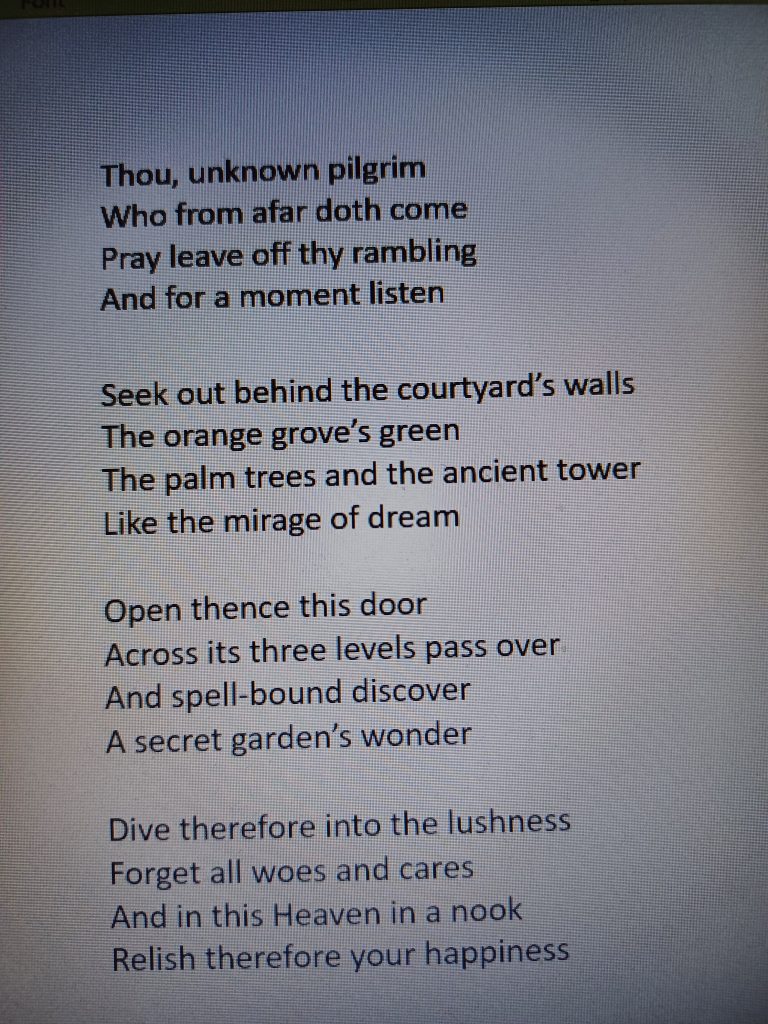
Djemaa El Fna is oddly quiet. I cross the busy road toward Koutoubia Mosque, outside of which men are praying. Ah, I thought I had heard the Muezzin calling the faithful to prayer. That explains why the snake charmers have left their snakes, and the conjurers paused their conjuring.
On my way back to my hotel, I pass the entrance to the Mamounia Hotel, the most famous hotel in Marrakech. Tempted, I cross over and enter in its sumptuous foyer. Wealthier clientele are catered for in the Mamounia, including a fair smattering of celebrities, but the management allows lesser mortals to stroll its gardens.
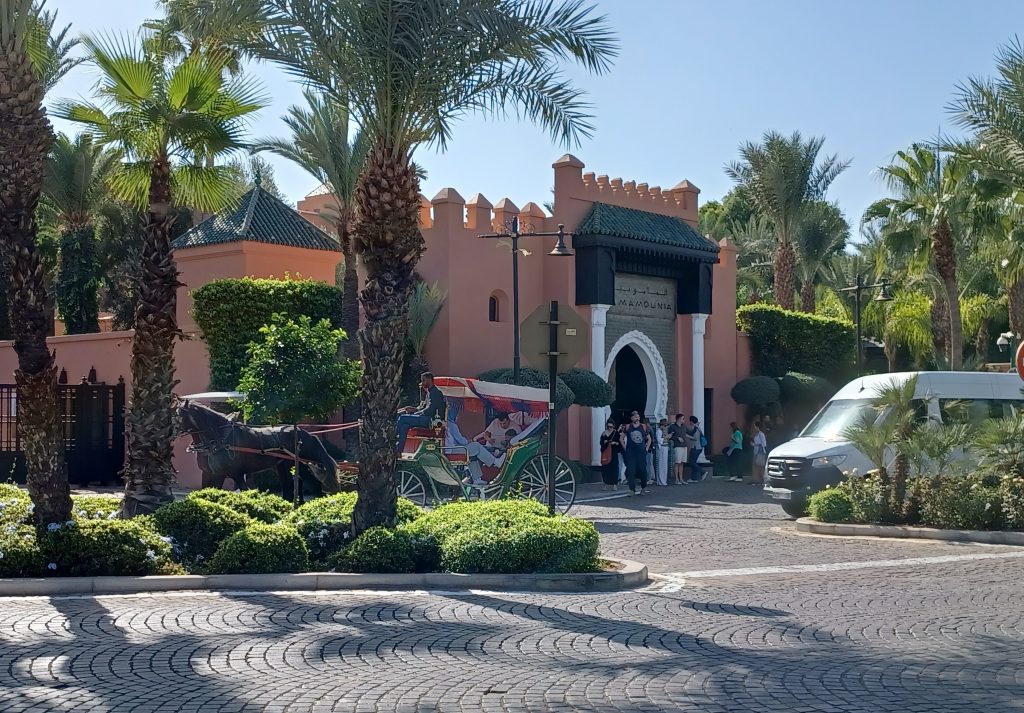
Our King Charles – when Prince of Wales – stayed here, Winston Churchill, Franklin D. Roosevelt, Nelson Mandela, Charlie Chaplin, Kate Winslet, Tom Cruise, to name a few. Off the main entrance hallway is a large pillared room with framed letters written by some guests thanking the staff for looking after them. Gorgeous décor inside, hammam, swimming pool and 20 acres of landscaped gardens.
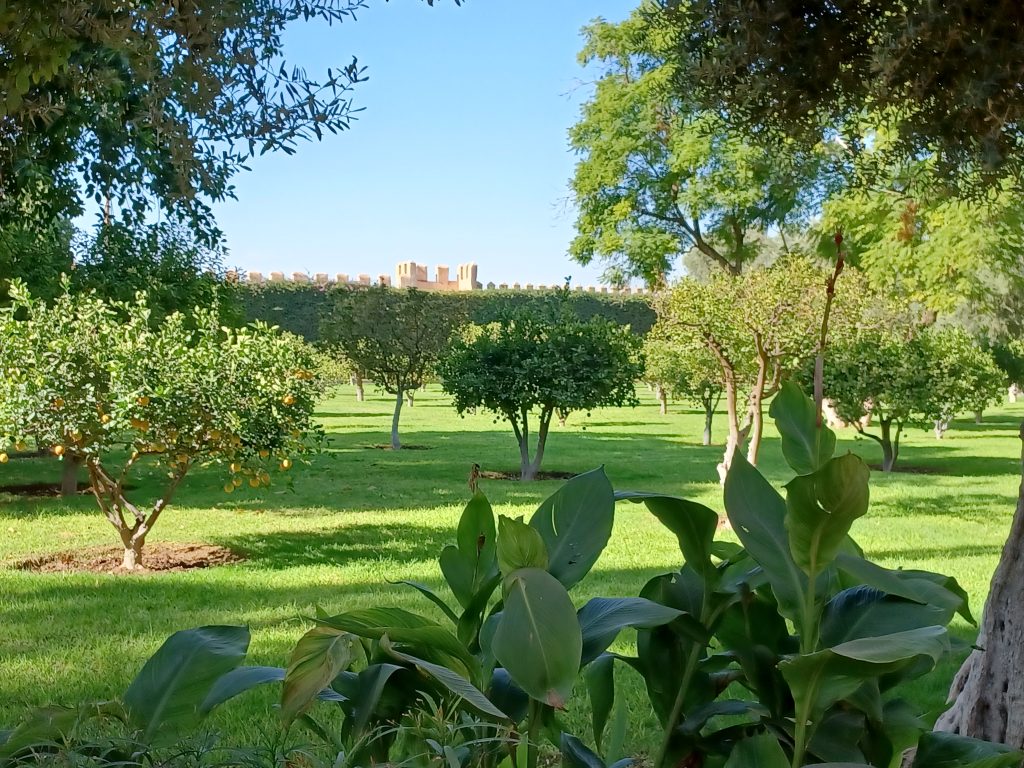
Tootle into said gardens. Churchill used to enjoy painting here I gather and his suite, the Churchill Suite, is available to rent. It overlooks them. I wander past the palm tree and cactus filled borders and amble through the orange groves. Only one or two others roam the pathways and a couple of tiny turtles wallow in a water channel.
Some sculptures of cacti adorn the borders. Painted red. And some giant spherical ones. Authentic cacti, I believe. Hotel guests are bathing in the hotel pool, others partaking of drinks in the bar. But I find a café in the middle of the gardens. Le Menzeh café. A smartly dressed waiter in waistcoat and white trousers stands next to a covered wagon. I order a costly coffee ‘Mamounia’ style. Sip it slowly, laze in the chair, gaze at the greenery. Glorious and far from the madding crowd.
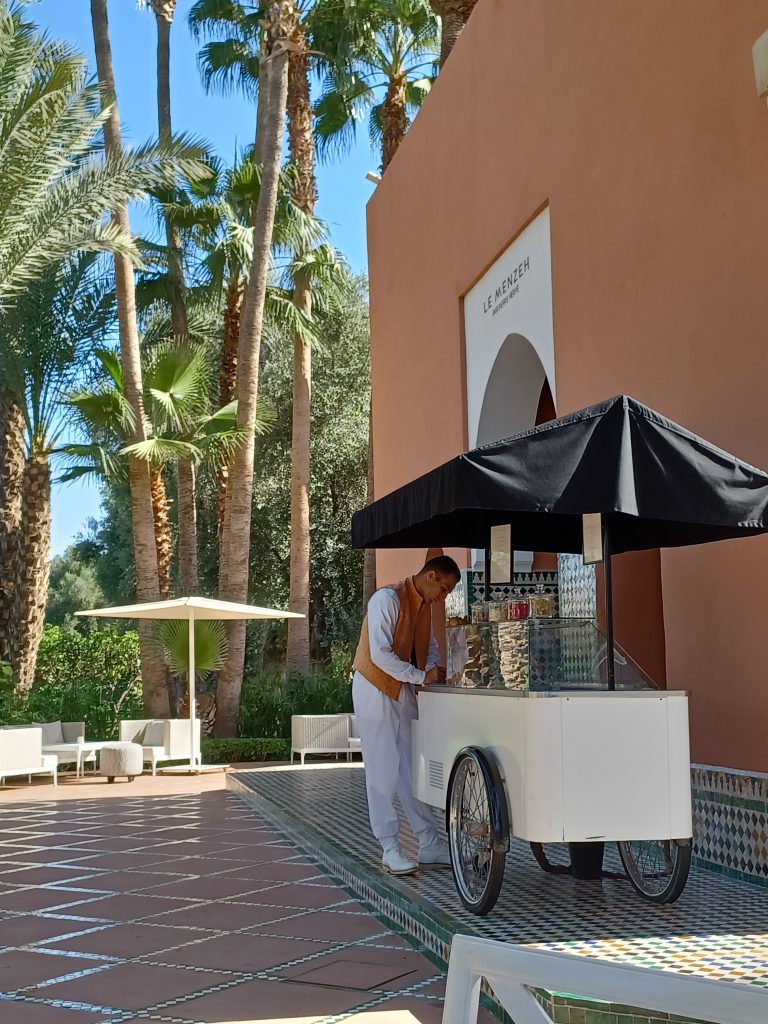
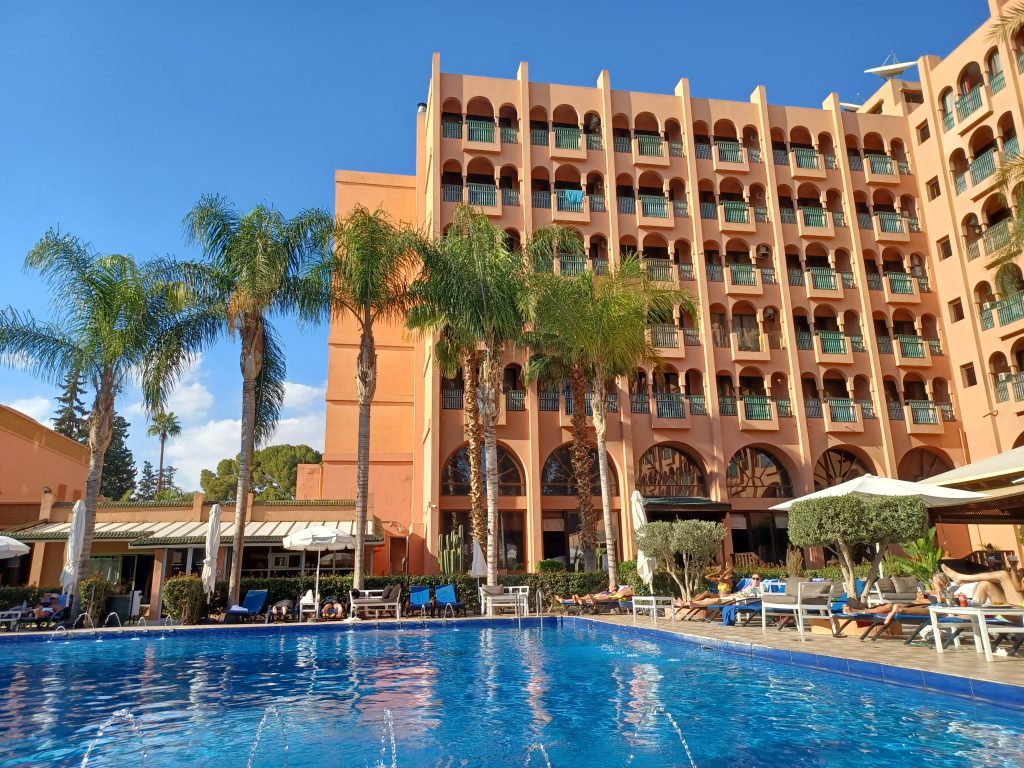
Back to my Hotel Al Andalous to lie by the pool a while and ponder. Not a bad recce of the town at all, I feel. Look round furtively to see if I can spot possible participants on the forthcoming tour. No likely candidates. Meet them all plus tour guide at the specified time and prepare for the adventures to come.

Leave a Reply